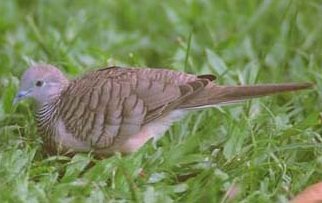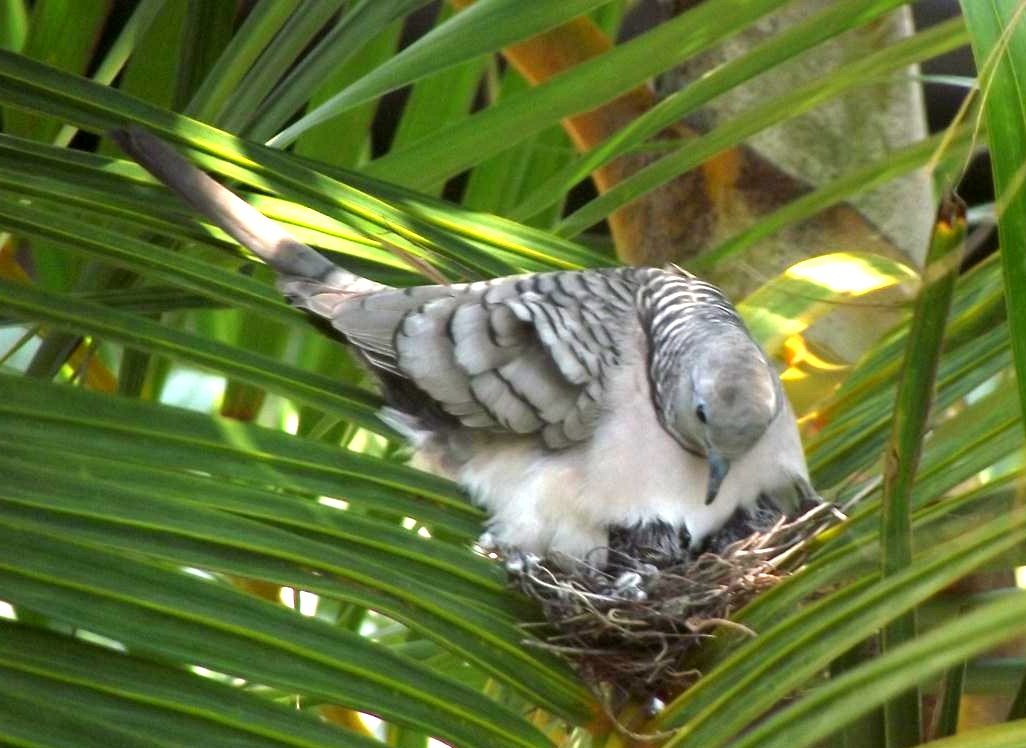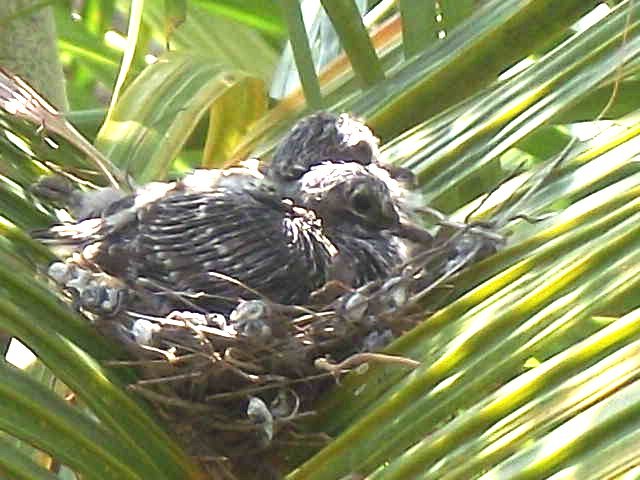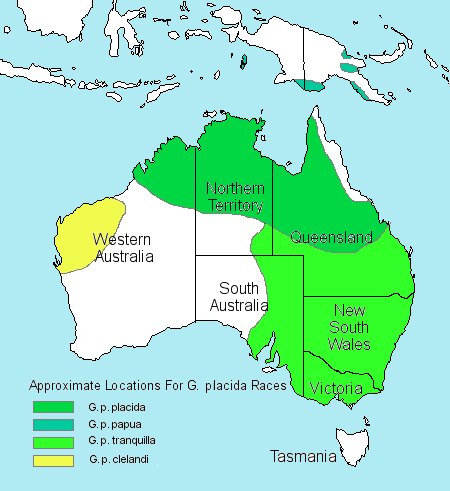MAIN MENU
Diamond Doves
Site Map
Diamond doves
Acquiring Diamond Doves
Caring for Diamonds
Living With Diamonds
Raising Diamonds
Growth of a Baby Diamond
One Year's Reproduction Data
Tribute to China
Other Dove Species
Other Geopelia Species... Diamond Dove
... Zebra Dove
... Barred Dove
... Peaceful Dove
... Bar Shouldered Dove
Ringneck doves
EurasianCollared Doves
Cape doves
Mourning doves
Mourning Dove Baby Growth
Rock doves
North American Doves
Dove Genera of the World
All Doves
Caring for Injured or Sick DovesTaming Doves
Other
Books of Interest
Some Bird stories
About Me
Links
Informational Sites
American Dove AssociationCommercial Sites
Jeff Dowining - Diamond DovesGarrie Landry - Diamond Doves
Wade Oliver - The Dove Page
Doveland Press - Diamond Doves
Peaceful Dove
Geopelia placida (Gould, 1844)

Peaceful Dove
Photograph by Philip Hamilton, Australia
Introduction
The peaceful dove is also sometimes called the zebra dove, barred dove, or the turtle dove. Many internet sites in Australia refer to this species as Geopelia striata as there is still some debate about the separation of G. striata into three separate species. Brown (1) reports that recent taxonomic work has shown that the peaceful dove should be a separate species because of its plumage (barring around the front of the throat vs. barring only on the sides of the throat, the size of the bird, and the birds' call. While the barring is distinctive, the length and weight data provided by Gibbs (2) does not show a significant difference between the peaceful dove and the zebra dove.
Description
Peaceful doves are about the same size as the zebra dove. The barred dove is somewhat larger than either the zebra dove or the peaceful dove. The peaceful dove does have barring completely across the neck and upper chest while the zebras dove's barring is restricted to the sides of the throat and chest.
Distribution
Four geographical races have been described for this dove but Gibbs reports the differences between the races are slight and of thus doubtful validity. The four races and their locations are described below:
- G. placida placida - northern Australia and probably south-east New Guinea
- G. placida papua - New Guinea
- G. placida papua - southern Australia
- G. placida cleandi - western Australia
Habitat
Peaceful doves are usually found in dry, open grasslands with some scrub vegetation which is used for cover. They are also found in Eucalyptus forests and in other dry, wooded areas. But like most Geopelia doves they prefer to have a source of water nearby. These doves can also be seen in villages and towns and in gardens and parks, and also in cultivated areas.
Feeding
Feeds on small seeds of native grasses and weeds where the ground is bare in open spaces. The bird walks and runs about very quickly while feeding. Brown (1) reports that insects are rarely eaten
Nesting
Peaceful dove on nest
Brown (1) reports that breeding can occur any time during the year however breeding may be less frequent during dry periods and also during cold weather. Gibbs (2) state that breeding in the south occurs only during the summer months while breeding in the north is year around. The peaceful dove starts up to eight clutches in a season.

Peaceful dove hen on her nest
The nest is usually a loose construction of twigs built in a shrub or tree from two feet to thirty six feet above the ground. Two white eggs are laid and are incubated by both of the parents for 13 to 14 days. When the babies hatch thy weigh about 6 grams. Growth is rapid. The babies obtain full feather cover at about ten days but al the under feathers are not completely grown in until around 24 days after hatching. The babies leave the nest in 14 to 17 days (1)(2) and like many other dove species they will spend most of the first week on the ground as their parents teach them how to improve their flying abilities, how to find food, how to avoid predators, and where to find safe places to roost for the night. Like diamond doves, they are usually self sufficient three weeks after hatching. (1)

Baby peaceful doves about six days old
All photographs in this section were taken
of wild doves and provided by: The peaceful doves' juvenile
plumage is duller than their parents. The bars on the body are less
well defined and and the top pf the head is without bars, The skin
around the eyes is gray for the first three or four weeks and then changes
to blue, Full adult plumage is obtained three months after hatching.
(1)
Emergency Feeding
Adult doves can be fed finch seed
or a budgerigar mix. These seeds can be supplemented by the use if egg
and biscuit mix, chicken starter, and crumbles. (1) For more
variety see the food section on the Caring for Diamonds page of this web
site. Vriends (4) also recommends soaked seed, white bread softened in
milk, and baby bird formula for chicks still in the nest. Feeding
techniques can also be found on the Raising Diamonds page. These doves
tame easily and adults will soon accept food from one's fingers (4).
References
(1) Brown, Danny, "Peaceful
Dove, Geopelia placida" A Guide to Pigeons, Doves &
Quail, Their Management, Care & Breeding, South Tweeds Heads, Australia:
Australian Birdkeeper 1995, pp. 117-119
(2) Gibbs, David; Barnes, Eustace; Cox, John "Peaceful Dove,
Geopelia placida", Pigeons and Doves, A Guide to
Pigeons and Doves of the World, London: Yale University Press 2001, pp. 289-291
Last revised on: October 5, 2011
(3) Goodwin, Derek, "Zebra Dove, Geopelia striata", Pigeons and Doves of the World, London: Trustees of the British Museum (Natural History), 1967, pp.
172-173
(4) Vriends, Matthew M., PhD., "Peaceful Dove (Geopelia [placida]
striata tranquilla)", Doves, A Complete Pet Owner's Manual. Happauge, NY: Barrons Educational Series, Inc., 1994 ,
p. 85
Helen White
P. O. Box 367,
Tallahassee, FL 32302-0367
